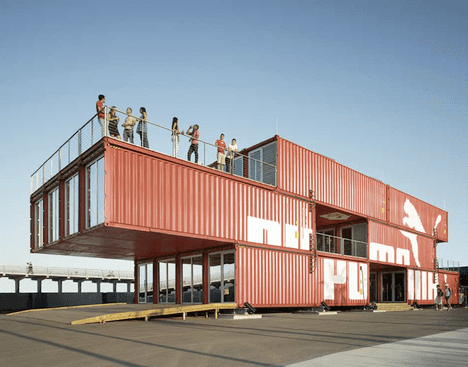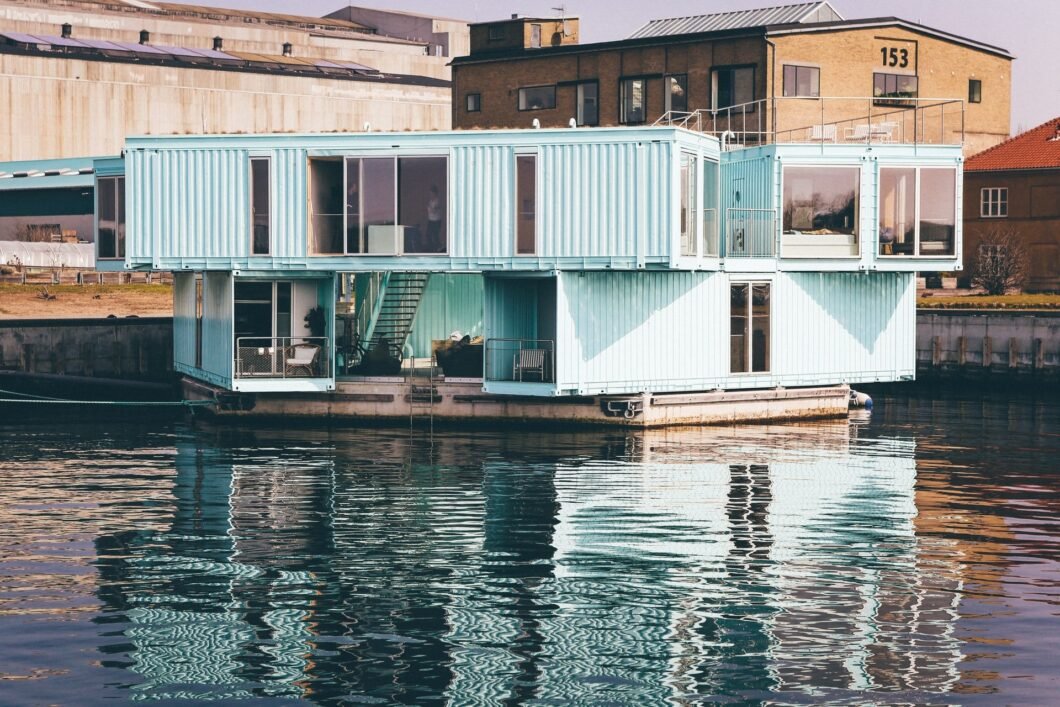With the growing popularity of ecological principles worldwide, an increasing number of individuals are turning to innovative container architecture as a sustainable and cutting-edge alternative. This architectural approach leverages the countless empty and underutilized containers scattered in ports around the globe, transforming them into impressive habitable and functional structures. This trend represents a clever response to the issue of empty containers that, due to their high cost of return, tend to accumulate in docks and port areas, consuming valuable space.
The genesis of this revolutionary architectural concept dates back to a patent filed on November 23, 1987, by Phillip C. Clark in the United States. This patent, granted on August 8, 1989, under the number 4854094, outlines a “Method for converting one or more steel containers into a habitable building on a construction site and the product thereof.” This patent laid the groundwork for the subsequent proliferation of container-based architectural ideas.
You can read the complete story of “Who built the first container house” by clicking here.
The year 2006 marked a significant milestone in this field when Southern California architect Peter DeMaria designed the first two-story container home in the United States. This innovative design received structural approval under the stringent guidelines of the nationally recognized Uniform Building Code. An even more impressive testament to the potential of container architecture is Lot-Tek’s Puma City, a structure built from abundant and affordable materials without compromising design quality.

These examples epitomize excellence in container architecture, which is gaining prominence in the realm of design as a stylish and eco-conscious alternative to conventional construction methods. Container architecture embraces environmental consciousness and presents itself as a smart choice for those seeking to blend style, functionality, and sustainability in their architectural projects.
However, despite its advantages, container construction also poses considerable challenges. For instance, the coatings used to protect containers during maritime transport contain harmful chemicals such as chromate, phosphorus, and lead-based paints. Additionally, the wooden floors that line many container buildings are infused with hazardous chemical pesticides like arsenic and chromium to repel pests.
While container reuse might seem like a low-energy alternative, the energy required to make a container habitable is often overlooked. A thorough cleaning process involving sandblasting, floor replacement, and cutting of openings using tools like torches or saws is necessary. On average, a container generates nearly a thousand pounds of hazardous waste before it can be repurposed into a habitable structure. Furthermore, the transportation of these containers necessitates the use of fossil fuels and heavy machinery, significantly contributing to the ecological footprint of the process.
Another limitation of container construction is its dimensional nature, which can result in uncomfortable living and working spaces. The length and narrowness of an individual container, combined with its ceiling height of less than eight feet, may be inadequate for creating a comfortable living space. The need to combine multiple containers to achieve an adequate-sized space adds an additional energy component to the process. In many instances, constructing a similarly scaled structure using wooden frames may be more cost-effective and energy-efficient.
In addition to the aforementioned challenges, careful planning and consideration of logistics are crucial when implementing container architecture projects. Transforming these elements into habitable structures requires meticulous planning in terms of location, design, insulation, and basic amenities. Adapting containers to meet housing and safety standards may require significant investments in terms of time, effort, and financial resources.
Thermal and acoustic insulation is a critical aspect of container design and construction. Since cargo containers are not initially designed for habitation, their capacity to maintain a comfortable temperature and reduce noise may be limited. The installation of appropriate insulation systems can significantly enhance energy efficiency and habitation comfort, but again, this involves design and cost considerations.
Despite these challenges, there are specific contexts where container architecture shines with full potential. Developing nations and areas affected by natural disasters often benefit from this form of construction due to its modular nature and ability to provide quick and affordable shelter. In these circumstances, container architecture can make a significant difference by offering timely housing solutions and functional spaces.
Furthermore, container architecture can also be an intriguing option in places where the availability of traditional building materials is limited. Containers can serve as a viable alternative to create durable and functional structures in remote or challenging-to-access areas.
Ultimately, the choice of container architecture as a design and construction approach depends on a range of factors, including project goals, local context, budget constraints, and environmental considerations. As awareness of sustainability and resource reuse continues to grow, container architecture is likely to continue evolving and adapting to address current and future challenges.
In Summary: Container Architecture
Offers a captivating and environmentally conscious alternative to traditional construction methods. It harnesses the surplus of vacant containers in ports worldwide, transforming them into functional and livable structures. While it faces challenges related to materials and planning, this form of architecture possesses undeniable potential in contexts with limited resources and immediate shelter needs. Embracing container architecture can not only foster creativity and innovation in architectural design but also contribute to the pursuit of sustainable solutions for global housing challenges.
While container architecture represents an innovative and appealing option for sustainable and environmentally aware construction, it is not without challenges. The transformation of containers into homes and functional spaces involves significant environmental and energy considerations. Although this architectural form fits excellently in situations with limited resources, abundant containers, and immediate shelter needs, its suitability in terms of design and construction may vary across different scenarios. As with any architectural approach, it is essential to carefully weigh the benefits and limitations before committing to container architecture in a specific project.
 «Tu casa con contenedores» es la única guía paso a paso que existe para construir tu propia casa con containers desde cero. No importa si no tienes conocimientos sobre construcción, si pensar en ello te da dolor de cabeza, si eres constructor o trabajas en una oficina. La guía está escrita para que cualquiera pueda entenderlo. MAS INFORMACIÓN CLIC AQUÍ Construye Tu Casa con Contenedores Paso a PasoHágalo Usted Mismo
«Tu casa con contenedores» es la única guía paso a paso que existe para construir tu propia casa con containers desde cero. No importa si no tienes conocimientos sobre construcción, si pensar en ello te da dolor de cabeza, si eres constructor o trabajas en una oficina. La guía está escrita para que cualquiera pueda entenderlo. MAS INFORMACIÓN CLIC AQUÍ Construye Tu Casa con Contenedores Paso a PasoHágalo Usted Mismo




